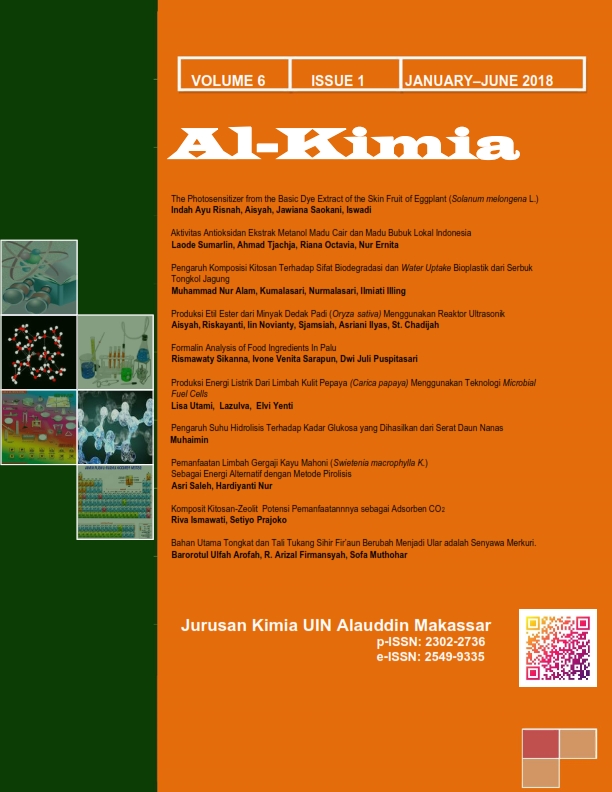Produksi Energi Listrik dari Limbah Kulit Pepaya (Carica papaya) Menggunakan Teknologi Microbial Fuel Cells
Abstract
Microbial Fuel Cells (MFCs) is a technology that can produce electricity whilst at the same time treat wastewater. MFCs convert the chemical energy of organic substrates into electricity through catalyzing the anaerobic oxidation process in the anodic compartment by bacteria as a catalyst. This study investigated the generated electricity using peel papaya (Carica papaya) waste. Peel papaya waste was used as the electron donor in the anaerobic anode compartment and KMnO4 was used as acceptor electron in the cathode compartment with methylene blue as mediators. The maximum power density, current, and voltage respectively were 121, 70 mW/m2, 1,79 ampere and 1,095 V at 17 days operation. The pH of the solution was increased from 3,54 to 6,64 on day 12.
Downloads
References
Chae, Kyu Jung. Choi, Mijin. Ajayi, Folusho F. Park, Wooshin. Chang, In Seop dan Kim, In S. (2008). Mass Transport through a Proton Exchange Membrane (Nafion) in Microbial Fuel Cells. Energy & Fuels (22):169-176.
Chirag K, Shah dan Yagnik B. N. (2013). Bioelectricity Production Using Microbial Fuel Cell. Research Journal of Biotegnology, Research Journal of Biotecnology, (8)3:84-90.
Idris, Sitinoor Adeib, Esat, farah Nasyitah, Rahim, Ain Adilla Abd, Rizzqi, Zahin. (2016). Electricity Generation from The Mud by Using Microbial Fuel Cell. JCCPE.
Kim, K. Y., Yang, W., & Logan, B. E. (2015). Impact of electrode configurations on retention time and domestic wastewater treatment efficiency using microbial fuel cells. Water Research, 80, 41-46. DOI: 10.1016/j.watres.2015.05.021
Kumar, A., Kumar, N., Baredar, P., & Shukla, A. (2015). A review on biomass energy resources, potential, conversion, and policy in India. Renewable and Sustainable Energy Reviews, 45(May 2015), 530-539. DOI: 10.1016/j.rser.2015.02.007
Li, Fengxiang, Yogesh, Sharma., Yu. Li, Baikun Zhou, Qixing. (2010). Microbial Fuel Cells: the Effects of Configuration, Electrolyte Solutions, and Electrode materials on Power Generation. Appl. Jan;160(1):168-81. doi: 10.1007/s12010-008-8516-5
Liu H, Cheng S, Logan BE. (2005). Production of Electricity from Acetate or Butyrate using A single-Chamber Microbial Fuel Cell. Environ Sci Technol, 39(2), pp 658–662.
Logan, Bruce E. (2008). Microbial Fuel Cells. John Wiley & Sons. Inc, Haboken, New Jersey.
Momoh, Yusuf OL, Naeyor B. (2010). A Novel Electron Acceptor for Microbial Fuel Cells: Nature of circuit connection on Internal Resistance. J. Biochem Tech, (2)4: 216-220.
Pant, Deepak, Gilbert Van Bogaert, Ludo Diels, Karolin Vanbroken. (2009). A review of the Substrates Used in Microbial Fuel Cells (MFCs) for Sustainable Energy Production. Bioresource Technology. Mar;101(6):1533-43. doi: 10.1016/j.biortech.2009.10.017
Rabaey K, Lissens G, Siciliano S, Verstraete W. (2003). A Microbial Fuel cell Capable of Converting Glucose to Electricity at High Rate and Efficiency. Biotechnol, (25)18: 1531–1535
Ueoka, Nagayoshi, Sese, Naoko, Kouzuma, Atshushi, Watanabe, kazuya. (2016). Sizes of Anode and Cathode Affect Electricity Generation in Rice Paddy Field Microbial Fuel Cells. Journal of Sustainable Bioenergy system, vol. 6:10-15.
Wang, Chin-Tsan, Wei-Jung Chen, Ruei-Yao Huang. (2010). Influence of Growth Curve Phase on Electricity Performance of Microbial Fuel Cell by Escherichia Coli. International Journal of Hydrogen Energy, vol. 35(13): 7217-7223
Xinmin, Liu, Jianjun, Wu, Benyue, Gong. (2016). Series and Parallel Connection of Anaerobic Fluidized Bed Microbial Fuel Cell. IJAMBR, (4): 7-14.
Zhuwei Du, Haoran Li, Ting Yue Gu. (2007). A State of the Art Review on Microbial Fuel Cells: A Promising Technology for Wastewater Treatment and Bioenergy. Biotechnology advance. Biotechnol Adv, 25(5): 464-482.
Copyright (c) 2018 Lisa Utami, Lazulva Lazulva, Elvi Yenti

This work is licensed under a Creative Commons Attribution-NonCommercial-ShareAlike 4.0 International License.
Authors who publish with this journal agree to the following terms:
1) Authors retain copyright and grant the journal right of first publication with the work simultaneously licensed under a Creative Commons Attribution License that allows others to share the work with an acknowledgement of the work's authorship and initial publication in this journal.
2) Authors are able to enter into separate, additional contractual arrangements for the non-exclusive distribution of the journal's published version of the work (e.g., post it to an institutional repository or publish it in a book), with an acknowledgement of its initial publication in this journal.
3)Authors are permitted and encouraged to post their work online (e.g., in institutional repositories or on their website) prior to and during the submission process, as it can lead to productive exchanges, as well as earlier and greater citation of published work (See The Effect of Open Access).


